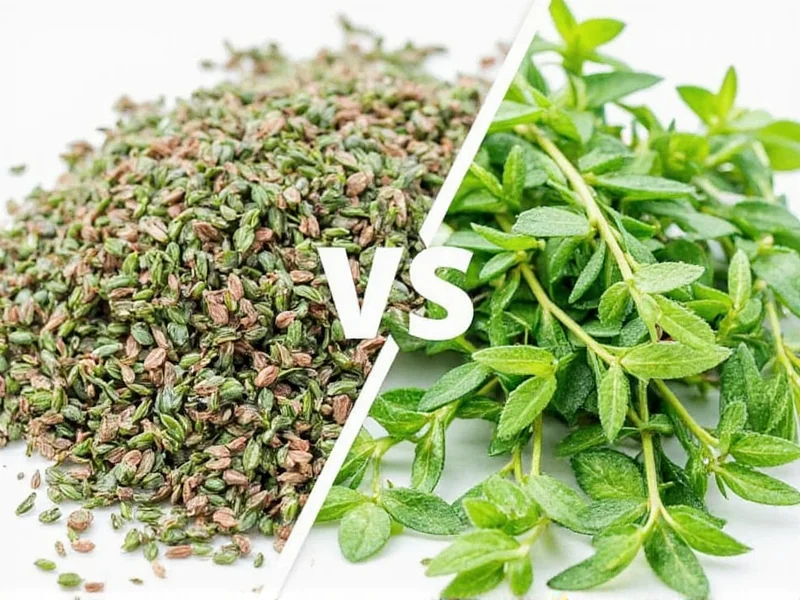When converting dry thyme to fresh thyme in recipes, use a 1:3 ratio—1 teaspoon of dried thyme equals 1 tablespoon of fresh thyme. This conversion accounts for the concentrated flavor of dried herbs compared to their fresh counterparts.
Understanding herb conversions is essential for achieving balanced flavors in your cooking. Dried thyme undergoes a dehydration process that intensifies its flavor compounds, making it significantly more potent than fresh thyme. This concentration explains why you need less dried thyme than fresh when following recipes.
Why the 1:3 Conversion Ratio Works
During the drying process, thyme loses approximately 70-80% of its water content. This concentration means dried thyme delivers a more intense flavor profile. The essential oils that give thyme its distinctive taste become more potent when water is removed. Professional chefs and culinary experts consistently recommend the 1:3 ratio as the standard conversion for thyme and most other woody herbs like rosemary and oregano.
Dry Thyme to Fresh Thyme Conversion Chart
| Dried Thyme | Fresh Thyme Equivalent | Best For |
|---|---|---|
| ¼ teaspoon | ¾ teaspoon | Delicate sauces, dressings |
| ½ teaspoon | 1½ teaspoons | Marinades, egg dishes |
| 1 teaspoon | 1 tablespoon | Most recipes, standard conversion |
| 1½ teaspoons | 4½ teaspoons | Hearty stews, braises |
| 1 tablespoon | 3 tablespoons | Large batch cooking, roasts |
Practical Tips for Using Thyme in Cooking
When substituting dried thyme for fresh in your recipes, consider these professional cooking techniques:
- Add dried herbs earlier: Dried thyme benefits from longer cooking times to rehydrate and release flavors. Add it during the early stages of cooking, especially for soups, stews, and braises.
- Fresh thyme at the end: Add fresh thyme toward the end of cooking to preserve its delicate flavor and vibrant color, particularly in finished dishes or garnishes.
- Crush dried thyme: Rub dried thyme between your fingers before adding it to release essential oils and enhance flavor distribution.
- Taste as you go: Always adjust seasoning gradually, especially when converting between dried and fresh forms, as individual palates and herb quality vary.
Flavor Differences Between Dried and Fresh Thyme
While the conversion ratio provides a mathematical equivalent, understanding the flavor profile differences helps you make better culinary decisions. Dried thyme develops earthier, more concentrated notes with subtle camphor undertones, while fresh thyme offers brighter, grassier flavors with citrus notes. In delicate dishes like fish preparations or light sauces, fresh thyme often provides a more nuanced flavor. For heartier dishes like roasted meats or bean stews, dried thyme's concentrated flavor can stand up better to long cooking times.
Storage Guidelines for Maximum Freshness
Proper storage significantly impacts thyme's potency and affects your conversion accuracy:
- Fresh thyme: Store in the refrigerator with stems in water (like flowers) and cover loosely with a plastic bag. Use within 1-2 weeks for optimal flavor. Older fresh thyme may require slightly more quantity in conversions.
- Dried thyme: Keep in an airtight container away from light and heat. Properly stored, it maintains potency for 1-2 years. After this period, you may need to increase the amount slightly as flavor diminishes over time.
Common Conversion Mistakes to Avoid
Many home cooks make these errors when converting between dried and fresh thyme:
- Using equal measurements: Treating dried and fresh thyme as interchangeable without conversion leads to overpowering or weak flavors.
- Not adjusting for age: Older dried herbs lose potency, requiring slightly more than the standard ratio.
- Ignoring recipe timing: Adding fresh thyme too early in cooking diminishes its flavor, while adding dried thyme too late prevents proper flavor development.
- Overpacking dried thyme: Scooping dried thyme directly from the container compacts it. Instead, spoon it lightly into measurements for accuracy.
When to Adjust the Standard Conversion
While the 1:3 ratio works for most applications, certain cooking scenarios warrant adjustments:
- Long-cooking dishes: For recipes simmering over 2 hours, reduce dried thyme by 25% as flavors continue to concentrate during extended cooking.
- Delicate dishes: In light sauces or seafood preparations, use a 1:2.5 ratio to prevent overwhelming subtle flavors.
- Older dried herbs: If your dried thyme is over a year old, increase the amount by 20-25% to compensate for flavor loss.
- Personal preference: Adjust based on your taste preferences—some palates detect thyme's bitterness more strongly than others.
Measuring Techniques for Precision
Accurate measurement makes a significant difference in herb conversions:
- For dried thyme: Spoon lightly into measuring spoons without packing, then level with a straight edge.
- For fresh thyme: Strip leaves from stems, gently pack into measuring spoon, and level without compressing.
- When precision matters: Use a kitchen scale—1 gram of dried thyme equals approximately 3 grams of fresh thyme.











 浙公网安备
33010002000092号
浙公网安备
33010002000092号 浙B2-20120091-4
浙B2-20120091-4